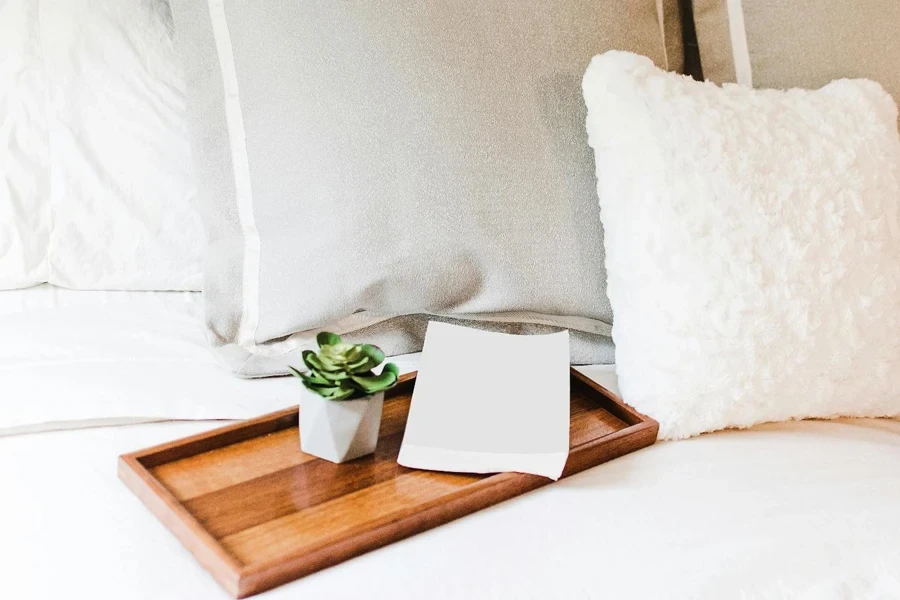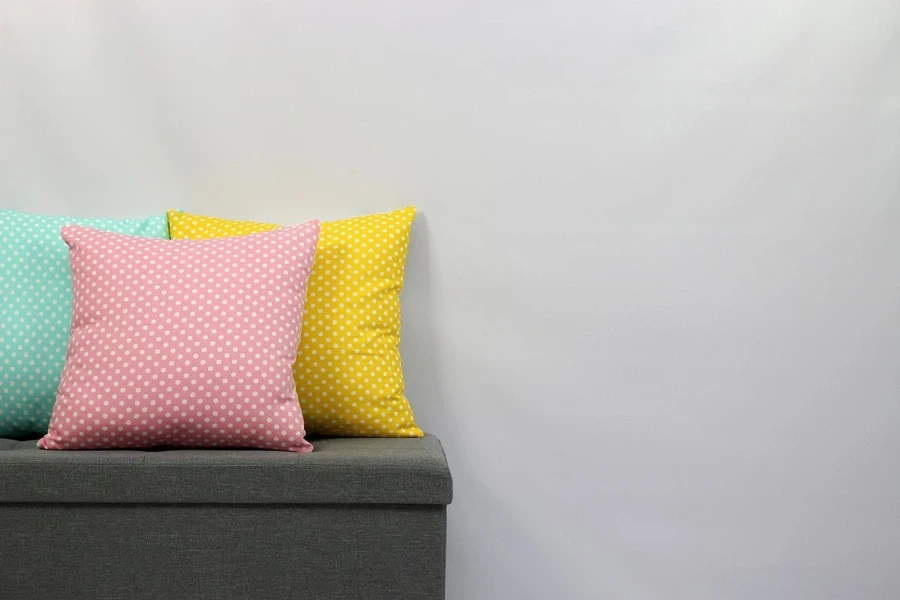Adding decorative and throw pillows to the design can greatly enhance the look of a room and also offer some comfort benefits. This is particularly important for those looking to buy home items as it allows them to stay up to date with the trends in eco-friendly materials and personalized designs that consumers seek. This piece delves into types of throw pillows by shedding light on their materials, shapes, and textures while providing valuable advice on choosing the right options for different living spaces. By matching their product offerings with these trends and demands, retailers can meet customers’ changing requirements in homes and workplaces. Choosing the ideal throw pillows enhances the visual appeal and fulfills practical needs, enhancing customer happiness and dedication.
Table of Contents
● Market overview: Trends shaping the global decorative pillow industry
● Exploring types of throw pillows: Shapes, materials, and textures
● Selecting the perfect throw pillows: Key factors for making the best choice
● Conclusion
Market overview: Trends shaping the global decorative pillow industry

Market valuation and growth
The value of the decorative pillow market stood at $5.84 billion in 2023. Per verified market reports, it is anticipated to hit $7.47 billion by 2030 with a compound annual growth rate of 4.3% during the projected period. This expansion is mainly fueled by the growing fascination of consumers with sprucing up their homes, adding personalized touches, and following design trends that focus on comfort and style. The desire for budget-friendly options to spruce up home decor continues to drive the popularity of decorative pillows in homes and businesses.
Shifting consumer preferences and market dynamics
The increasing popularity of personalized pillows is a significant factor contributing to this growth trend today, mirroring the broader consumer interest in sustainable home goods. People are more interested in materials like organic cotton, recycled fabrics, and natural dyes as they become more aware of how their buying choices affect the environment. Verified Market Reports states that online retail expansion also fuels this market growth by providing consumers with a wider selection of designs and simpler customization opportunities. Throughout the year, different styles and designs in clothing become more popular due to consumer changes and fashion trends, which greatly influence what consumers prefer regarding patterns, color choices, and fabric types.
Exploring types of throw pillows: Shapes, materials, and textures

Shape and style variety
Throw pillows come in shapes and designs to suit different aesthetic and practical preferences. For instance, square pillows are a loved choice and usually come in standard measurements, like 16 x 16 inches or 24 x 24 inches. It is ideal for bringing balance to your seating or bedding setups. Lumbar pillows are appreciated for their qualities in seating spaces and come in sizes like 12 x 24 inches or 14 x 36 inches to offer comfort and elegance to seating arrangements. Theyhelp alleviate pressure on the lower back and contribute a stylish, elongated shape to seating decor. Bolster pillows, usually cylindrical in design with dimensions like 8 x 30 inches or 10 x 27 inches, are another popular option, offering decorative appeal and neck and arm support, often used on beds or daybeds.
Specialty shapes are becoming increasingly popular, providing unique accents to furniture. Round pillows, for example, range from 14 inches in diameter to larger 32-inch styles that can even double as floor cushions. These shapes are ideal for breaking up the rigid lines of modern furniture, adding a soft, fluid contrast to rectangular or square seating. Pillows in novelty shapes—such as U-shaped or even star-shaped designs—offer a playful or thematic element, making them suitable for children’s rooms, creative spaces, or eclectic interiors.
Material choices
The fabric for a throw pillow determines its comfort, durability, and visual appeal. Cotton and linen are great choices because they’re breathable and sturdy, making them perfect for places with lots of activity or warmer weather conditions. Linen pillows especially get a lot of love for their knack for staying cool and retaining that appearance even after years of use. Linen pillows, in particular, are praised for regulating temperature and maintaining a natural, textured look even after long-term use. For more luxurious settings, velvet pillows with a pile height between 3 to 5 mm are highly sought for their rich texture and visual depth. Velvet’s plush surface adds softness while its weight ensures that it stays firmly in place, making it an excellent choice for formal and casual living rooms.
Faux fur and wool materials are perfect for seasonal use, particularly during colder months. Faux fur pillows often come with a pile length of up to 50 mm, replicating the luxurious feel of natural fur while being more accessible and animal-friendly. Wool, known for its excellent insulation properties, is often used in chunky-knit designs or textured weaves, adding warmth and visual appeal. These materials are suitable for creating a cozy, inviting atmosphere in bedrooms and living rooms.
Texture and pattern trends

The feel and designs of cushions enhance the look of space alongside their form and fabric type. Pillows with tufted detailing and elaborate buttoned patterns bring an air of timeless elegance and are suitable for various decor styles, be it traditional or modern setups. Typically tufted designs include buttons set deeply into the fabric with tension ranging from 2 to 4 pounds per inch (psi), creating a long-lasting appearance that holds up well over the years. Typically, three layers are involved with quilted pillows, a top fabric layer for comfort and design detail, padding, and backing for structure and support.
Embellishments, like embroidery and beading, are quite popular as they can add designs to a cushion and transform it into a statement piece of decor. These craft techniques involve an amount of detail with up to 10,000 stitches per meter to create elaborate and artistic motifs that showcase skilled handiwork. Geometric patterns and animal prints are trending in the design world and offer a striking visual impact in contemporary and mid-century spaces. Such patterns often feature color contrasts with a 2:1 or 3:1 ratio of dominant to accent colors, allowing them to stand out while complementing the room’s overall palette.
Advanced fabric technologies
Fabric technology advancements have enhanced the functionality and durability of throw pillows well. Several pillows now incorporate moisture-wicking fabrics borrowed from performance sportswear and are tailored for home textile use. These fabrics can soak up moisture from the air and dry rapidly, making them well-suited for areas or spaces prone to high humidity. UV-resistant fabrics treated with solution-dyed acrylic fibers are gaining popularity for pillows to prevent color fading due to prolonged sunlight exposure. These advanced materials are designed to endure harsh environments and prolong the durability of the cushions.
A notable advancement in pillow production is the increasing use of recycled materials. For instance, pillows crafted from polyester fibers provide both durability and softness akin to polyester options, albeit with a much lower environmental impact. Additionally, certain brands opt for fabrics that are OEKO-TEX® certified, guaranteeing that the pillows are devoid of substances and meet the rising preference for eco-friendly and ethically made household items.
Versatility in styling
Throw pillows are incredibly versatile in styling options since they offer a range of customization possibilities that cater to different preferences and tastes. Reversible pillows are particularly noteworthy for their ability to showcase textures or patterns on each side. This feature allows users to style their living spaces without investing in multiple pillow sets. This proves handy when it comes to changing decor. Homeowners can effortlessly transition from using lighter fabrics, such as linen, during the summer months to opting for heavier materials, like wool or velvet, during winter. Blending textures, like combining velvet with coarse wool or incorporating pleats into plain designs, can add depth and style to minimalist decor schemes.
Selecting the perfect throw pillows: Key factors for making the best choice

Size matters
Selecting the right pillow size is important to create a sense of balance and harmony in a room’s design scheme. The size of the pillows should match the scale of the furniture they accompany. For instance, standard square pillows (usually 16 x 16 inches or 18 x 18 inches), are perfect for average-sized sofas and chairs, while bigger 24 x 24-inch pillows are suitable for sectionals or larger seating setups. Extra-large pillows such as Euro pillows (typically 26 x 26 inches in size) are perfect for beds as they provide both a decorative touch and comfortable support for lounging or reading activities. It’s important to choose pillows that complement the size of the furniture to avoid them looking too big or too small for the space.
Color and pattern coordination
Choosing colors that complement each other is essential for achieving an attractive design scheme. For instance, using pillows in analogous hues next to each other on the color wheel (like various shades of blue and green) can bring tranquility and balance. This method is particularly effective for creating atmospheres like bedrooms or cozy reading nooks. To create an ambiance in your spaces, opt for complementary hues. Those opposite on the color wheel are yellow and purple or blue and orange. To make a strong impression and infuse vitality into the room, it is crucial to harmonize designs with more straightforward ones. For example, combining a large-scale pattern with a smaller, understated stripe or a solid-colored cushion helps maintain a balanced aesthetic without overwhelming the overall look.
Balancing function and style
Decorative cushions should do more than look good in space; they should also provide comfort and assistance to those using them. When selecting pillows for ergonomic purposes, such as lumbar pillows, consider materials that provide firm but flexible support. Pillows with memory foam inserts or specially designed lumbar cushions are ideal for supporting the lower back, especially on deeper sofas or office chairs. In addition to comfort, it’s important to consider fabric durability and maintenance. For high-traffic areas, pillows made from durable materials like polyester blends or heavy-duty cotton are more resistant to wear and tear, while softer, more delicate fabrics like velvet or silk are better suited for less frequently used spaces.
Sustainable choices
As people focus more on eco choices when it comes to pillow selection, sustainability has emerged as a consideration factor in the decision-making process. Nowadays, many throw pillows are crafted from materials like cotton, hemp, or recycled polyester to lessen their environmental impact. For those who value eco-friendly products, GOTS-certified fabrics are a common preference, ensuring that the pillows are produced using organic materials and manufactured in adherence to stringent environmental and social standards. Pillows filled with recycled materials, like bottle alternatives, provide a sustainable choice that doesn’t compromise comfort or style. A good option is to choose pillows crafted with fabrics certified by OEKO TEX®, ensuring they are free from chemicals and safe for households with children or people with allergies.
Arranging pillows for maximum impact
Picking out the right throw pillows plays a key role in effectively improving the look and usability of any room. Businesses can enhance their offerings by keeping up with the trends in the market and advancements in materials and design techniques to deliver products that improve interior decor and cater to customers’ practical requirements. By making decisions regarding size, shape, materials, and placement, rooms can be turned into appealing and cozy spaces through throw pillows as a flexible and powerful design element.
Conclusion

Selecting the right decorative and throw pillows is an essential part of enhancing both the aesthetic appeal and functionality of any space. By staying attuned to evolving market trends, material advancements, and design techniques, businesses can offer products that not only elevate interior design but also meet the practical needs of consumers. Combining thoughtful choices in size, shape, materials, and arrangement can transform rooms into visually striking and comfortable environments, making throw pillows a versatile and impactful design tool.



